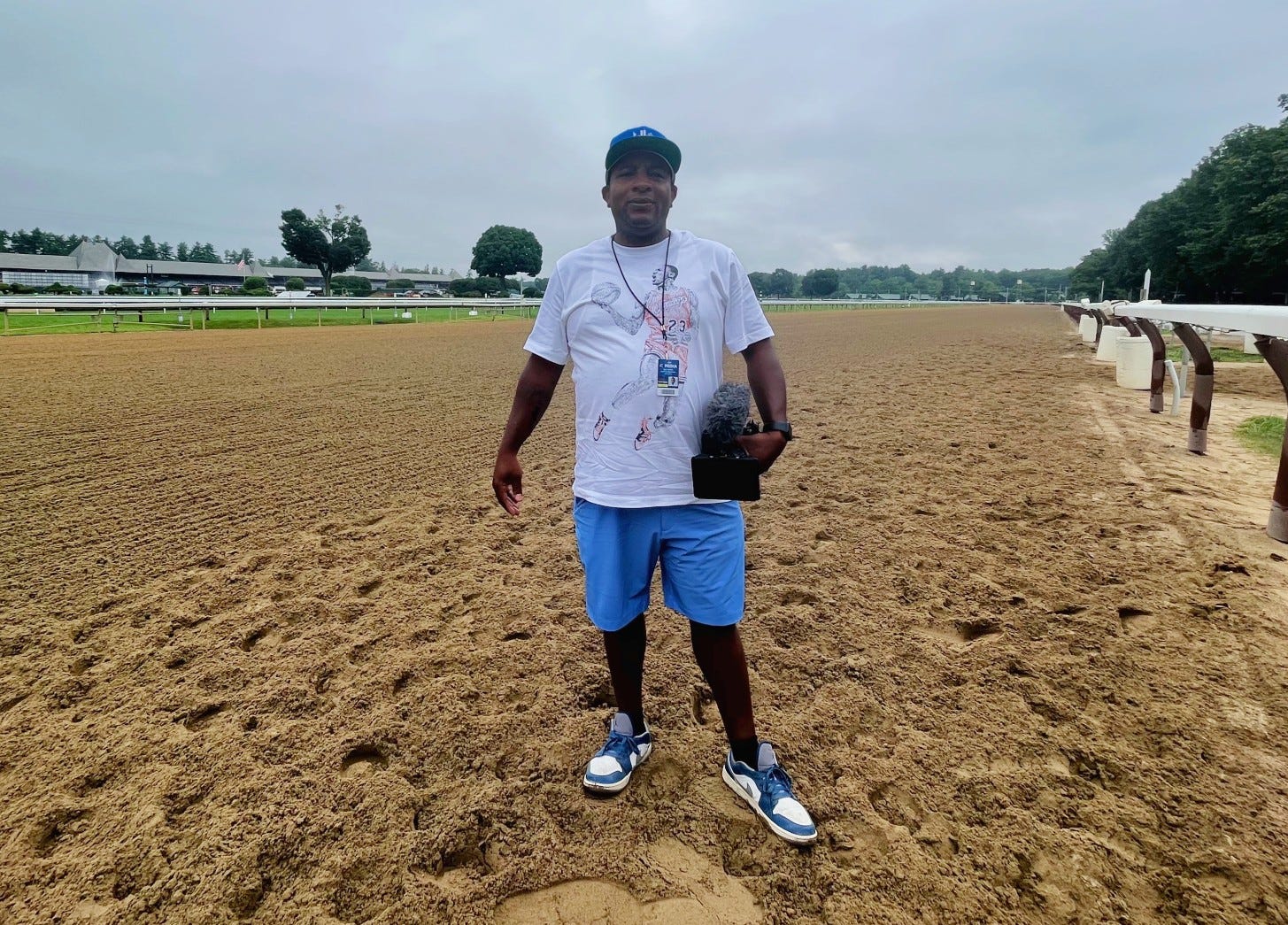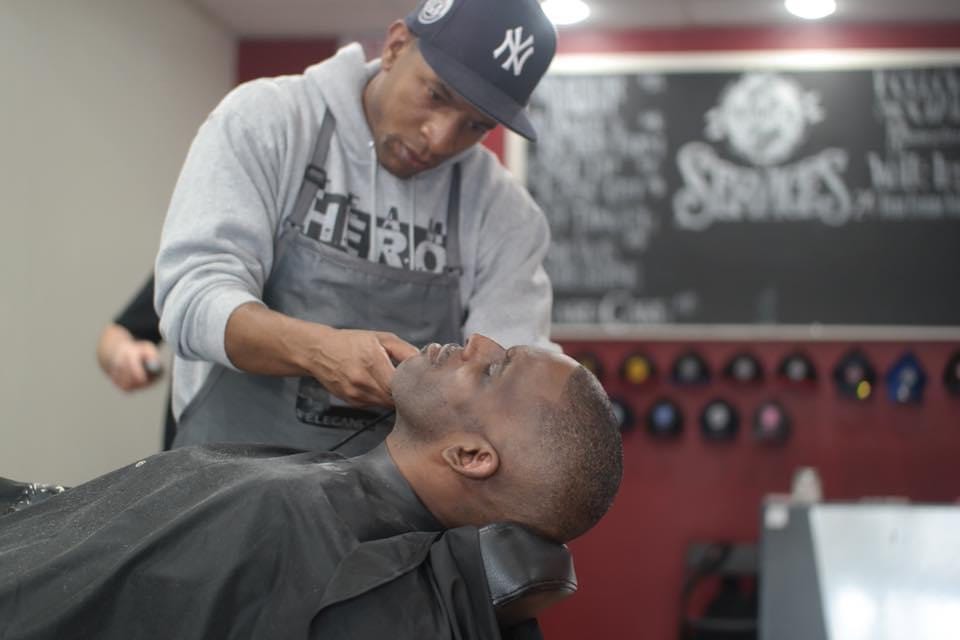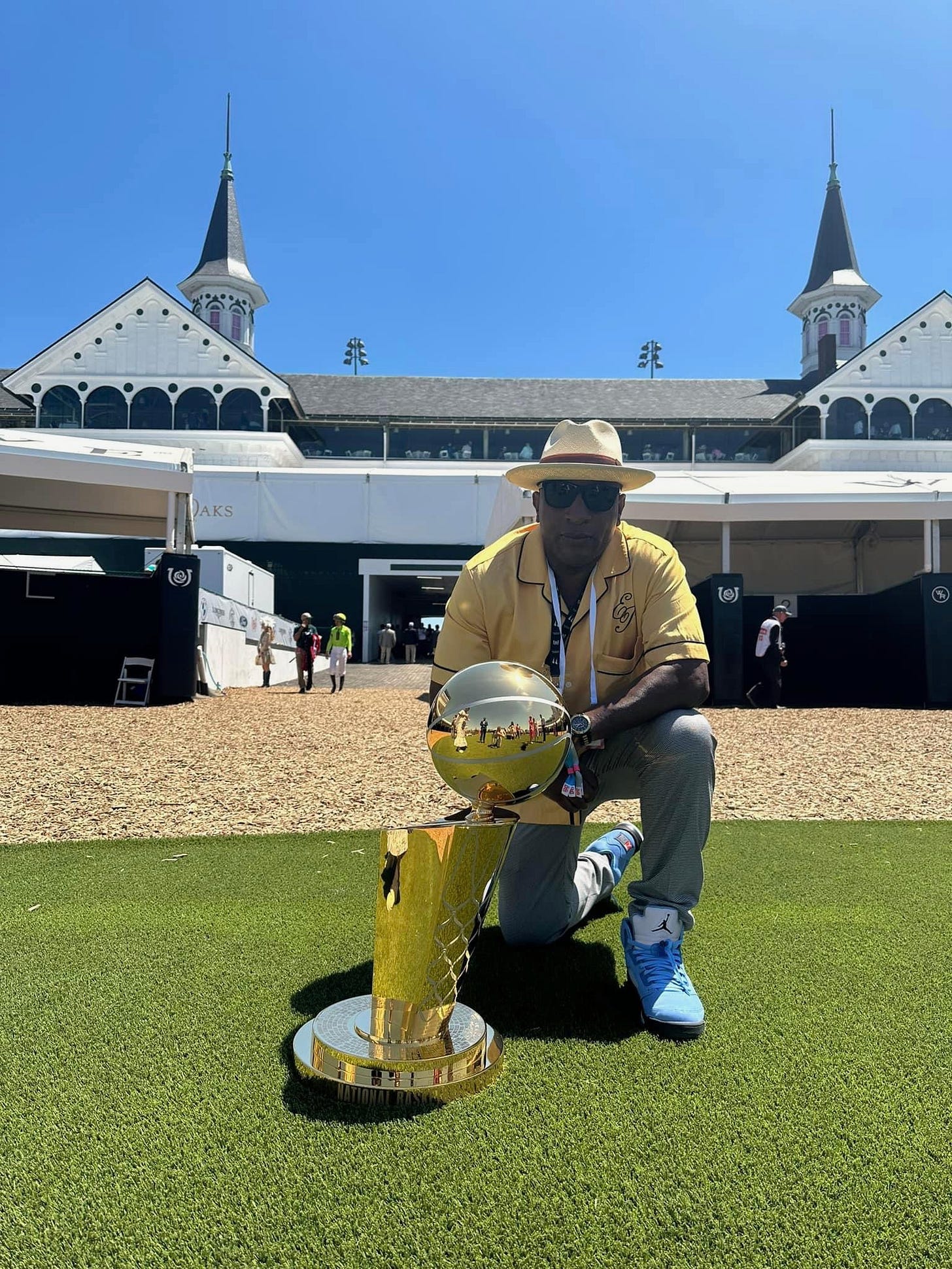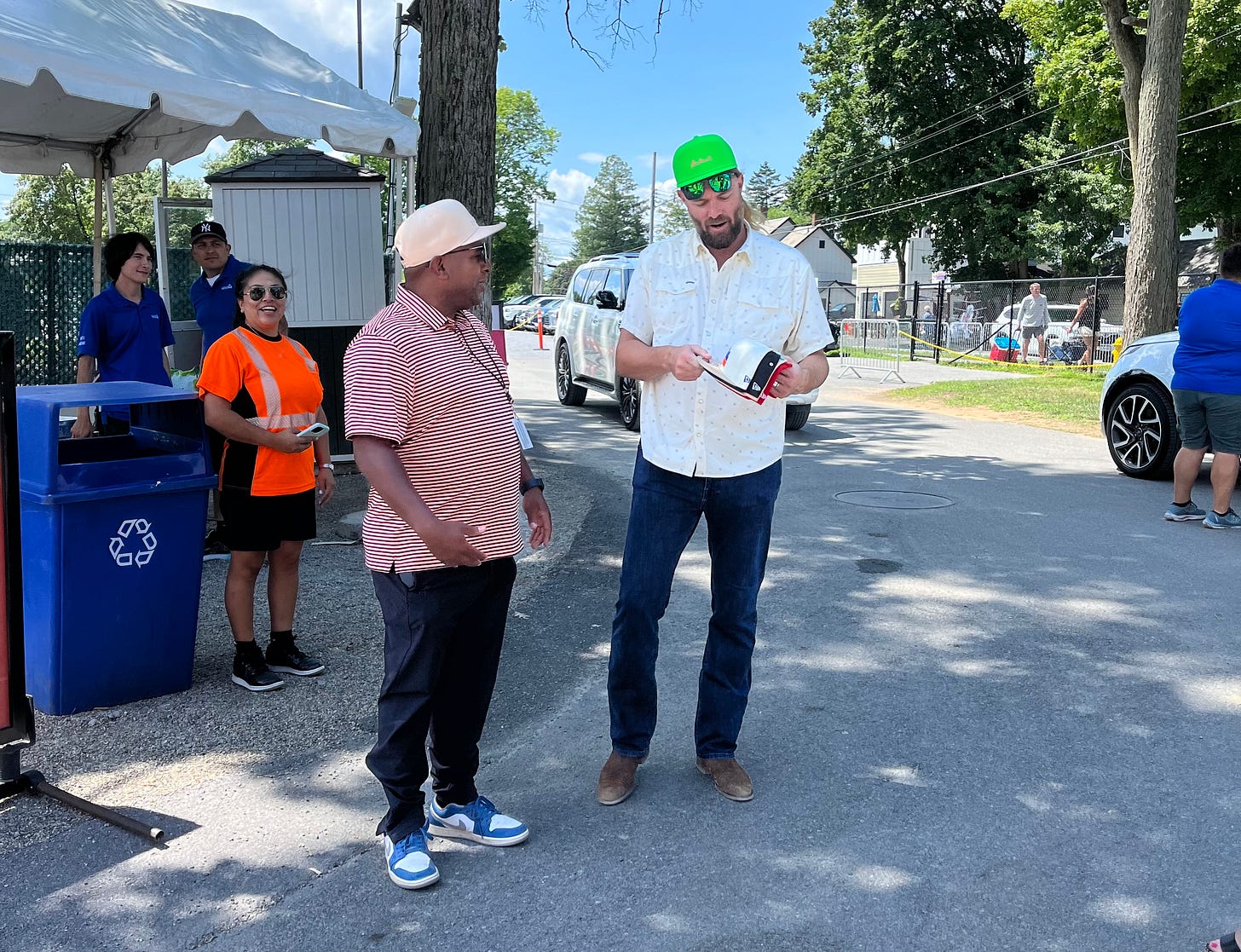Celeb Shot: Rasi Harper
The man behind The Real Players Inside the Backstretch is putting the human experience back in horse racing.

Two summers ago, someone—probably Rasi Harper himself—handed me a postcard-sized flyer promoting something called The Real Players Inside The Backstretch. I didn’t write a story on it at the time, but I put the flyer on my desk, where it got buried in my pile of “things I don’t know what to do with right now.”
After cleaning my desk recently, I rediscovered the flyer, and looked up The Real Players online. 31,000 followers on Instagram. 21,600 members of the Facebook group. 386,000 followers of the Facebook page. A big feature in the New York Times. And I’d been over here sitting on the story for two full years.
“I do a lot of stuff to create content,” says Harper, a master barber who’s turned his penchant for barbershop chitchat into a platform that shares the stories of backstretch workers. “I’ve got a hat brand called Don’t Hide the Plug where I sell hats. I do free haircuts for the homeless and veterans every month. We’re into content. And nothing takes off. But with the Real Players Inside the Backstretch, right away, people found the videos. I didn’t have to ask nobody to share it. I swear, this is the only content that I’ve seen people find just organically. I just put the videos out and the page keeps growing.”
The videos in question? Rasi’s signature, unplanned, “silent ambush”–style interviews with the people who make horse racing happen, or, as he calls them, “The Real Players.” A Real Player could be anyone from a famous horse trainer to a virtually unknown farrier—Rasi doesn’t discriminate, and believes everyone, from Chad Brown to hot walker Larry Zardes, has a story to tell. Since mainstream media tends to focus on the negative side of horse racing, Rasi has made it his mission to show the positive, personal side. And his followers can’t get enough. “People love the stories,” he says. “I get emails from people all over the world. It should be a notice for the industry that these are the stories that people want.”
I caught up with Rasi last week at The Morning Line, the town square of the backstretch community, to talk about his organic rise to racing industry royalty and his plans to take The Real Players Inside The Backstretch—both the brand and the people it covers—to the next level.
SLAH: Where are you from and how’d you wind up here?
RH: I grew up in Flatbush, Brooklyn. My brother was going to college up here at Hudson Valley and I moved up here following him. I'm a master barber, so my purpose of coming here was to cut hair and for a change of environment from growing up in the city life. I visited my brother in Albany and I liked it, and then I discovered Saratoga throughout the years.
How did you become interested in the horse racing world?
I worked in a barbershop on Henry Street, and it was all horse guys. All the owners and trainers were coming to this barbershop. Javier Castellano would come in, Kendrick Carmouche…Chad Brown was a regular. That’s how it started—just chatting with them. They started telling me their early stories about how they got in the game. Their family was horsemen from the south, and you start hearing about the grooms and how they took care of horses and their kids. The way they talked about the game and described it was just fascinating to me. And then in the afternoon, the races come on TV. They’re all watching the races and I’m watching along with them, but I didn’t see what I was hearing. I ain’t see none of the stories I was hearing—all these great stories about horsemen and how they loved horses. So I’m like, it’d be a cool idea to do a podcast in the barbershop.

Did the podcast ever happen?
Everybody was excited. Like, “great idea, love it.” So I started looking for a filmmaker. I found one guy and he came in and we’re pitching the story to him. He looked at us and it was like $2,000 an episode. Everyone went blank. Nobody wanted to invest in that. So for all my supporters, that took the air out of the tank, right? But for me, it didn’t take the air out of the tank. I still believed in the idea.
What’d you do?
Years went by. I knew it was a great idea. Like, this is it—you couldn’t talk me off the ledge. Covid came and everything shut down. I went out and spent my last $15,000 at B&H. I got a PPP loan, took the whole check and invested in cameras. Didn’t know how to use a camera, so I’m watching Peter McKinnon and other creators on YouTube. I’m teaching myself how to film, and in 2020 I started a Facebook group. It was only stories—no videos yet—and people loved it. Right away, I was getting a response. I got 10,000 subscribers in this group and I’m like, man, this thing is really moving.

Has your style of reporting and focus on the backstretch ever gotten you access that other reporters may not have had?
We went to the Kentucky Derby in 2022. Rich Strike, long shot, 80-1. I interviewed the groom and that whole connection on the backside two or three days before the Derby. He had no shot. Nobody was looking at this horse. Then we’re at the Derby…Rich Strike wins the Derby. I got the exclusive interview of this situation. No media was even back there after he won the Derby. I got the original first content. It’s my biggest video to date on YouTube: almost half a million views.
What are some of the best stories you’ve heard on the backstretch?
The people that have the best stories are the guys that are with the horse every single day. The owner’s not with the horse every day. The jock’s not. It’s the grooms and the hot walkers. Deadeye in Louisiana’s got a good story. He was a horseman/trainer. A Black cowboy. He grew up on the bush tracks, started at age 9, hiding from his parents in a time when it wasn’t cool for young black kids to be in the bushes riding horses. Roy Seales was another good story. He’s from the Virgin Islands. True, true horseman. These are the guys that never really got their shot never really got the big break to be trainers. Even though they might be grooms and low-level trainers, they could’ve been big—just ain’t had the opportunity.
What have you learned in the years you’ve been doing this work?
What I learned is that this is really a family. People are more connected than you think. You might talk to one person, and just because they work for a different trainer, you might think it’s a whole different outfit. But these people have known each other for 25 years. And the beauty about what I do is I don’t leave nobody out. We wanted to tell it in the entirety. I didn’t want to just go with all the black guys, though there’s a whole lot of history there: We were the original horsemen, original jockeys. Fifteen of the first 28 to win the Kentucky Derby were African American. I could’ve gone in that direction, but I wanted to tell it from a perspective of every nationality as a family. Because it is that way.
Is there anything about horse racing that you think needs to change?
They need to do a better job at celebrating the people that work behind the scenes. This is hard work. People back here are busting their butts, and it’s not about money. These people are dedicated to these horses. And a little recognition—just telling their stories—is important. The game doesn’t do good at celebrating history. You know what I mean? You go to the Kentucky Derby; the next day it’s over. It's like it never happened. The Real Players is different.

What are you working on now?
This year I’m working on a film, and I’m working on a series. The film is pretty much my journey. This is like a dream in my head, but I'm trying to figure out how to get to every major race this year coming up. And then I want sit down with the footage and take it in a direction. But it’s going to be a love story—the people’s story. And the series is kind of like an Anthony Bourdain type of vibe. You go to cool cities in horse racing, so we want to talk about inside the track and outside the track. Saratoga’s the major leagues, but then you got a lot of small tracks with people that have horses racing for small purses. It’s a different game there. They would love to tell their story.
What’s next for the brand?
I want to add more experts. I want to add a Spanish-speaking person that could translate. I want to create an international database of every person that works in the industry. One major wish I have is to give away a million dollars: $5,000 to 200 people that work in the industry on the backside. I'm just trying to expand the platform, and it’s all learning. I don’t got no sponsorships. Everything’s outta pocket. I don’t even know how to get sponsorships, so everything is me teaching myself and figuring it out in real time. I’m not a horse expert, and it shows. But it doesn’t matter, because my platform is about love.
—Natalie
Quote of the Week
“The only time I ever got hurt I was sober.”
—Overheard at Collins Park in Scotia
Disc Jockeys
What do Shaboozey and Jose Ortiz have in common? Well, for one, they both sing a mean rendition of “A Bar Song.”
Jose’s moment in the spotlight came this past Sunday at Vapor Night Club when he performed in the Jockey Karaoke Contest to benefit the Permanently Disabled Jockeys Fund. “He’s by himself singing?” a guy standing behind me said as Jose took the stage. “That’s ballsy.” Jose, the reigning champ of the annual competition, put on quite a show, but in the end had to pass the people’s choice crown onto John Velazquez and his wife, Leona O’Brien, who performed a Grease-inspired duet.
Other highlights of the night? Judges choice winner Shane Sellers’ performance of “Deep River Woman,” Pace University a capella group Frequency’s performance of the Call to Post, Kim Weir’s dad’s retro Parting Glass T-shirt, sightings of a camera crew from Netflix there shooting an upcoming series on jockeys, judge Jayson Werth winning an authentic Belmont Park bench in the live auction, the heartfelt program that brought injured former jockeys up on stage, and, of course, emcee Tom Durkin. “This is the most fun night of the racing meet,” Tom said when he welcomed the crowd. “And it’s also the most meaningful. Now, and I mean this from the bottom of my heart: Turn off your cell phones.”
New Year, New Festival
After pulling off a successful Belmont on Broadway concert, local organizations including the Saratoga County Chamber of Commerce, Discover Saratoga and the Saratoga Springs City Center are once again teaming up with the Proctors Collaborative to present a free night of live music. The upcoming event is Saratoga New Year’s Eve, which will feature a free outdoor concert outside the City Center, fireworks and live music at multiple downtown venues on—you guessed it—New Year’s Eve. (Live music acts will be announced in the coming months.) Festivities will conclude on New Year’s Day with the annual Saratoga First Day 5K.
Does all this sound vaguely familiar? Saratoga has been putting on a New Year’s celebration since the mid-1990s; it was originally called First Night, and following two years off due to Covid, switched over to New Year’s Fest when 398Group’s Robert Millis got involved. This next iteration looks much the same as New Year’s Fest, and Millis, who apparently had a falling out with the other organizers, is considering taking legal action, and/or putting on his own New Year’s festival.
Red Carpet Treatment
Yesterday, jockey Joel Rosario, our Races Issue cover star, was inducted into the horse racing hall of fame at a ceremony hosted at Fasig-Tipton. The fanfare continued over at the track, where fans greeted Joel on a red carpet outside the jockeys room.
Open for Biz
About a month and a half after an electrical fire shut down several businesses on Phila Street, The Magic Moon is finally back up and running. “It's been a long "glitch" in the Matrix & we miss you...& while you're at it, please give the other local businesses that were without power some love too,” reads a recent @magicmoon518 Instagram post. “This was a VERY bonding experience with too many people to even mention, LOVE we will never forget.”
Olympic Update
It’s a disappointing week for the Capital Regionites representing Team USA in the Paris Olympics. Saratoga-based rowers Kristi Wagner and Lauren O’Connor both failed to advance to the A finals, and rowed in the B finals in their respective disciplines earlier this week. Both teams finished third in the B finals, or 9th place overall.
On Wednesday, Glens Falls native Jimmer Fredette, who came out of retirement to play for the 3x3 men’s basketball team, suffered an apparent groin injury during a game against Poland. He didn’t play in Team USA’s games on Thursday or Friday, but his teammates squeaked out a pair of wins to bring their record to 2-4. They need to win their final pool play match on Sunday to advance.
Perhaps the Capital Region’s best hope for a medal is Rudy Winkler, the Albany-born hammer thrower who notched 77.29 meters on his first attempt in yesterday’s qualification round. That throw earned him a spot in the hammer throw final on Sunday, which will air at 2:30pm EST. Check out Rudy’s conversation with Kristi on her podcast, The Other 3 Years, above.
ICYMI
Empire Media Network (EMN), the parent company of Saratoga Living, Capital Region Living, and Saratoga’s Best, announced last week that Director of Content Natalie Moore would assume the role of editor of the three storied publications. In this position, she will work closely with Saratoga Living Sales Director Annette Quarrier and Capital Region Living Publisher Teresa Frazer as well as EMN Chief Operations Officer Tina Galante to produce the top-of-the-line magazines upstate New Yorkers have come to know and love, in addition to Saratoga Living After Hours and ancillary print products for iconic local organizations such as Saratoga Performing Arts Center and Albany Symphony. EMN Owner Anthony R. Ianniello, Esq. will remain the company’s chairman.












